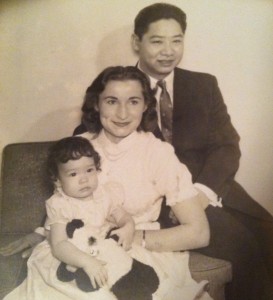Dec. 7, 1941, is a day remembered for world conflict as the Japanese bombed Pearl Harbor and spurred the United States to enter World War II. But fourteen years later, that day would also be remembered as the occasion when two families put aside their cultural differences to celebrate the interracial marriage of my grandparents, Phillip and Margit Wong.
In 1951, Margit Wolfe, along with her parents, stepped off a ship onto Ellis Island and stared with open jaws at the majestic emerald statue of Lady Liberty. Filled with hope to start anew, they were welcomed into a farming community in Iowa and eventually moved to Akron, Ohio, in search of work.
While waiting to hear from the restaurant manager of Wong’s Garden regarding her new employment, Margit sat in a single booth table twiddling her fingers just as Phillip Wong, a WWII Navy Veteran, strolled through the door.
He paused, stared right at her and shouted to his brother, “Who the heck is that?”
Despite the fact that Margit only knew German and struggled with her English, the Wong family desperately needed more help and immediately hired her as a waitress.
“One day, someone asked for the sports page, so I went to the kitchen and ordered the sports page, not knowing that it wasn’t an entree,” Margit said.
As the days progressed, Phillip soon became Margit’s mentor. He taught her English, but most importantly, he made sure she was safe.
“He started to call taxis to take me home from the restaurant when I would leave at night and even had a friend of his drive me home,” said Margit.
The immigrant from Germany and the Chinese American-born veteran courted and displayed their affections in peculiar ways. They never labeled their relationship or stated that they were dating. To them, words were not necessary.
“I can’t remember dating, but when I worked part time to go to business school, he bought me a typewriter,” said Margit.

The Wong family’s first portrait with their daughter in 1956.
On Sep. 19, 1954, Phillip tossed a diamond ring onto Margit’s lap, and they were engaged.
During that time in the 50s, people thought they did not address their relationship or express their terms of endearment due to Margit’s language barrier or Phillip’s ethnic background, but that was not the case.
“We just knew. No one had to say anything,” said Margit. “We never experienced any judgment towards our marriage. If people were against us, well, they never said anything.”
Margit and Phillip did not see the harm in mixing races. Their families did not mind either, but they still refused to give their blessing to the young couple. They were not against the marriage based on Phillip’s race, but rather his religion–he was Catholic and she was a Protestant.
As soon as Margit was engaged, in order to prevent the marriage, her parents sent her away to Milwaukie, Wis., to live with family friends.
While Margit was away, Phillip moved to Florida to open a new Chinese restaurant but never stopped calling and writing letters to Margit. After many expensive long distance phone calls, the two families relented and allowed the couple to reunite.
Their marriage was further delayed though, as both Catholic and Protestant churches refused to marry them. They eventually married in a Congregational church and united as man and wife on Dec. 7, 1955.
With promises of moonlight swims and the beginning of new possibilities, the newlyweds moved to Miami, Fla., where they raised their first and only child.
“Whenever I had the baby, people always asked where I adopted her from,” said Margit. “I would say, ‘She’s mine!’ Then they would stop talking to me, and turn around.”
Phillip and Margit know that they are lucky. Other interracial couples faced many more obstacles of racial discrimination, but these two stood against the odds. Their story shows that yes, times have changed and the world is becoming more diverse and accepting of other cultures. Despite what many may hear, even during the pre-Civil Rights era, there were people who did not consider race as a barrier to relationships.
After 59 years of marriage, Phillip doesn’t say “I love you,” but he still tucks Margit in every night.